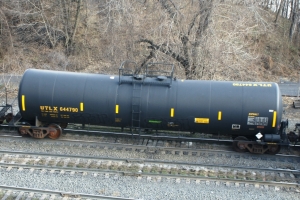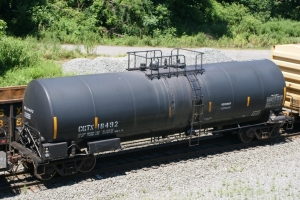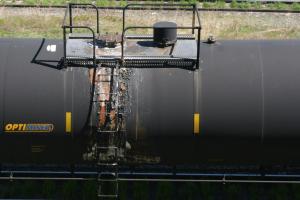Spring is finally here and road crews across the country are busy patching potholes and repaving roads. The asphalt that paves our roads often takes its first trip on the rails.

GATX 89282 carries a load of asphalt. Judging from the paint burned from the top of the car, those “HOT” warning placards are well heeded.
The car of choice of course for asphalt service is the tank car. Despite similar exterior appearances, tank cars are among the most specialized rail cars due to the unique qualities of the different loads they carry. Asphalt service tank cars are typically in the 23,000 to 26,0000 gallon capacity size and are insulated and heated. Both for heat retention and to minimize the weathering effects of the load, black is the paint color of choice. When loaded, asphalt cars carry “HOT” placards.

This UTLX tank is in asphalt service for only a few months. An outer “skin” hides the heating coils and insulation which are wrapped around the actual tank itself.
Asphalt is produced at refineries all around the country. From there it typically moves in bulk aboard rail cars to regional distribution centers or manufacturing facilities. In addition to paving, asphalt is also used for roofing materials, and as a coating or component on many other building materials and products as diverse as battery cases and tires. If the final use site isn’t directly served by the railroad, as in most road projects, the asphalt can be transloaded into tank trucks for delivery. These unloading operations may be modeled with very minimal space and can work well for an easy industry on a model railroad.
While the insulation in the tank cars keeps the asphalt from completely hardening in transit, additional heat is often necessary to get the sticky liquid to unload efficiently. Typically the car is warmed by filling the heating coils along the exterior of the tank with steam. Other heated liquids or gasses can also be used. Once heated, the asphalt can be pumped out of the bottom of the tank and into stationary storage tanks on site or waiting trailers.
As you can probably imagine, after emptying the tank there will still be some stubborn residue left inside. Typically about an inch of material will be left at the bottom. Cleaning the interior of an asphalt tank car must surely not rank high on anyone’s list of desirable jobs, but it must be done.
Before anyone can enter the tank to clean it, the car must be allowed to vent for several hours. The vapors inside the car are not only toxic, they can also ignite. Steam, hot diesel oil, caustic soda, detergents and cold water can all be used. Between the venting and cleaning, it can take several hours to prepare an asphalt tank car for its next load.
The latest method is to cool the car by pumping cold water into the coils and into the tank itself to a temperature of around 40°F. This hardens the asphalt so that it can be chipped and swept out as a solid. This is much faster and safer than the other techniques.
Aside from the “HOT” placards and other loading markings, asphalt tank cars can usually be picked out easily in a train. It doesn’t take too many trips before the cars develop thick black streaks down the sides near the loading hatch from spilled asphalt. It is also common to see the paint on the car burned off from the heat of the load. For those who like to weather their models, this is all part of the fun!
So the next time you have to dodge a pothole on the way to work, just think of all the business it means for the railroads!


We use to get Ink in tank cars shorter than these at the Washington Star, in the winter a steam line was hooked up to the car to warm it up. News paper ink is like thick molasses.
That’s very interesting. I’ll have to do some more research on those cars for a future edition!
Thanx for an informative, well-written article and for planting the seed of an idea for an additional industry.